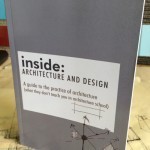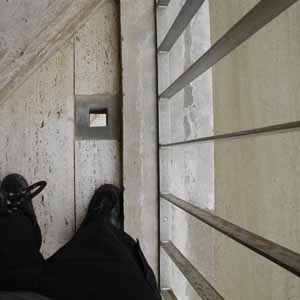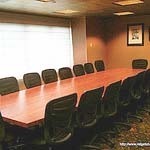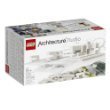Ryan Hansanuwat's Blog
August 1, 2014
Architecture Registration Exam (ARE) Tips and Tricks

 Architect Exam PrepMore than just a books, this is the best bet to get all of the exam information you need. Get the "whole enchilada" and get study guides, audio companions, flashcards and exam simulators. I used their whole enchilada to pass my California Supplemental Exam and this is absolutely the best deal you can find.
Architect Exam PrepMore than just a books, this is the best bet to get all of the exam information you need. Get the "whole enchilada" and get study guides, audio companions, flashcards and exam simulators. I used their whole enchilada to pass my California Supplemental Exam and this is absolutely the best deal you can find.

 Ballast ARE Review Manual
Ballast ARE Review Manual Great overall book that goes into a lot of detail. Good to review once you have a general grasp on the material and need more in depth information to really make it sink in.2. Get is scheduledThe first and hardest step in testing is getting started. So just do it, set a date and stick to it. Don't reschedule, don't cancel, just set yourself a deadline and work towards it. Trust me, this is the best way to force yourself to get the studying done. We are architects, we work best under pressure anyways right?This is by far the best thing you can do to force yourself to study. If you're tired after a long day of work, or you just want to hang out with your friends a little longer, the knowledge that you have a test coming up in a few days or weeks will remind you of what you need to do.3. Come up with a game planWhat order are you going to take your tests? It all depends on you and what you are most comfortable with. Some people like to start with the easiest exams first, giving them motivation as they go, while others want to get the hard one's out of the way, but it really depends on you. There are a million ways to go about it, but the most important thing is to sit down and write it out so you know what to focus on.
Great overall book that goes into a lot of detail. Good to review once you have a general grasp on the material and need more in depth information to really make it sink in.2. Get is scheduledThe first and hardest step in testing is getting started. So just do it, set a date and stick to it. Don't reschedule, don't cancel, just set yourself a deadline and work towards it. Trust me, this is the best way to force yourself to get the studying done. We are architects, we work best under pressure anyways right?This is by far the best thing you can do to force yourself to study. If you're tired after a long day of work, or you just want to hang out with your friends a little longer, the knowledge that you have a test coming up in a few days or weeks will remind you of what you need to do.3. Come up with a game planWhat order are you going to take your tests? It all depends on you and what you are most comfortable with. Some people like to start with the easiest exams first, giving them motivation as they go, while others want to get the hard one's out of the way, but it really depends on you. There are a million ways to go about it, but the most important thing is to sit down and write it out so you know what to focus on.For me the best plan was in this order: SD - The only graphics only test, which would force me to use their horrible CAD software SS & BS - Being fresh out of school (actually still in school) I knew this material was fresh in my mind and wouldn't be something I would learn on the job until later SPD, BCS, SPD & CDS - I saved these for the end, expecting that most of my learning in these areas would come from working in a firm.4. Go to arecoach.comGo to their forums and get and give advice. A great place to reach out with others who are in the same boat as you. This is a new forum that is based on the now defunct areforum.org that helped me out during my exams. It is mostly the same (mostly) helpful people who are there to help you study, and for free.These quick and easy tips are just the beginning of getting started on taking your exams, but hopefully these will inspire you to get started. What tips and tricks do you have? What order are you planning on taking? Let me know in the comments below.

The post Architecture Registration Exam (ARE) Tips and Tricks appeared first on Architecture Career Guide.
July 25, 2014
I don’t know what I’m doing

 You can pickup a copy of the book here. Please take a look at it and leave me an honest review.
You can pickup a copy of the book here. Please take a look at it and leave me an honest review. The post I don’t know what I’m doing appeared first on Architecture Career Guide.
July 11, 2014
Business for Architects

 No matter the phase you are in your architecture journey, knowledge of business for architects is a must. Whether you are just starting out, or ready to start your own firm, you must have a basic knowledge of business. This journey typically begins with classes in architecture school, but it is never too late to learn it.
No matter the phase you are in your architecture journey, knowledge of business for architects is a must. Whether you are just starting out, or ready to start your own firm, you must have a basic knowledge of business. This journey typically begins with classes in architecture school, but it is never too late to learn it.Go here if you want to start writing your own Architecture Firm Business Plan!Architecture school was one of the most exciting yet most tiring phases in my life. Even if you go to the best architecture school, you are still going to get overwhelmed by all of the design studios, architecture history classes and structures formulas. Architecture school takes a lot of effort from students and it is one of the most demanding majors on campus. But through all of this, if you are in architecture school, you should try to find some time to take classes outside of architecture. If you are not an architecture student, find classes through your local community college, or take online courses to get the information you need.Business Classes The most important aspect to being a successful architect isn't design (some might argue with me on this), but it is business savvy. You can be the best designer in the world, but unless you have the firm to get the client and make it a reality, it is just thoughts on paper. Business classes will teach you what you need to know to run a firm, or if that isn't your plan, to understand why the firm does what it does. You need to know that architecture is a business, and unless you want to be a starving artist, you must treat it as a business.Introduction to Business This is the first class you should take as it will give you the basics. What's the difference between an asset and a liability? Should I be a sole proprietor or LLC? These basics are a must for any business owner to understand and should be second nature to you. Even if you don't have an interest in running a business, you need to know what you are talking about when you are speaking with an accountant or banker, or even just filing your taxes.Basic Accounting If you want to be successful, you need to follow the money coming in and going out. You need to be able to understand what money you currently have (cash flow), and what you are expecting to have (Accounts Payable/Receivable). When it comes time to buy that new piece of software you need, where is the money going to come from? If you don't have any cash on hand, how are you going to pay for it? Being able to track your firm's money makes a huge difference in the success of the company.Personal Finance A must for anybody, whether you want to run a business or not, as it will teach you the basics of money. It is amazing how many architecture students leave college with little to no knowledge on credit, debt and how to handle money. Don't be one of these people. Learn how to manage your money properly and stay out of debt. Learn how and when to save any extra money you have in 401k's, IRA's or other savings options. This will benefit you in life and not just as an architect.Once you have taken all of these basic classes, what do you do with it? Your first step is to enhance your personal life, then you will use your knowledge to advance in the firm, finally, if you desire, you will be able to run a firm successfully.Your first job. The first thing you will use your new-found knowledge for is to get an understanding of how much money you need to make in your first job. What are your expenses, your current debt load and your repayment plan? Put together a list of everything that is going out and include things like rent, food, and travel. Also include in the list any payments you need to make for debt you incurred during college; such as student loans. Compare this amount to how much money architects make and make sure you can make it work. If your expenses are more than you can possibly make, reduce your expenses by doing things like drinking less Starbucks or even something as drastic as moving to a less expensive area.Advance in your architecture career When you are designing a project, basic business and accounting come into play more often than you think. You need it to factor in construction costs to your design, but as you start to manage the projects, you also need to understand internal hourly rates, scheduling and budgeting. When the project begins you should know the amount of time that is allocated for you to work on the project and ensure that you are working within those parameters. If you can show that you understand the need to keep a project on budget, internally and externally, you will show your value to the firm and provide more opportunities for advancement.Start/run a firm The most important need for business knowledge in architecture is in running a firm. If you plan on starting your own firm, or even running a firm, now is the best time to start writing your business plan. Seriously. Don't wait until you are 10 years into your career to start thinking about and imagining what you want your firm to look like. Start thinking about what interests you and what you want your ideal firm to look like. This will give you direction in your career in the type of firms you work for, the architecture project types you will chase and how you go about learning.Business plans are live documents that are meant to be changed and updated. It's ok to change your mind and pivot on what you want to do, but if you don't even have a place to start, you will wander around in your career not knowing what you want to do. I have been dreaming up my ideal architecture firm since I knew I wanted to be an architect and it has helped me stay focused and directed so that I went from an "Introduction to Architecture" class to firm principle in less than 10 years, and you can too, if you just start today.Business Plans for Architects If you are excited and want to learn more about writing a business plan for architects, I am currently working on my 16-session architecture business plan course that will walk you through step-by-step on how to write your own business plan. At the end of the 16 sessions you will walk away with a business plan geared specifically to your architecture firm that you can take to the bank (literally). If you want to learn more, go to www.architecturebusinessplan.com.
The post Business for Architects appeared first on Architecture Career Guide.
May 30, 2014
Gifts for Real Architects

Why “drafting” supplies don’t really help you in architecture.
When you first get started in architecture, you may feel overwhelmed by all the tools and kits out there that claim to have everything you need to get started. Some of them carry things you need, while many others do not, and the majority of the “kits” out there contain things that aren’t really used anymore. They were created with all the tools you need if you were hand-drafting, but nobody does that anymore. You still draw and sketch, but nobody is putting together construction documents using these sets.
Here is one example of a “drafting kit” offered in most stores:
Let’s see what they got there:
Compass – I don’t ever use that.
Triangles – Use them every couple of years, and only if I’m doing a precise sketch.
Protractor – Nope, don’t use that.
French Curve – Use every once in a while.
Sketch Pad – That’s tiny! I’ll just use a regular sketch pad.
Lead Holder – Most architects draw using much more than a pencil, mostly markers and pens.
Eraser – See above.
Architects Scale – Use this all the time, and thus I’d rather get a more durable scale than this cheap plastic one.
If you are going to get serious about doing architecture, here is what you really need to get started:

 Aluminum Architect Scale – Strong and durable for everyday use.
Aluminum Architect Scale – Strong and durable for everyday use.
 Faber-Castell Pitt Brush Pen
Faber-Castell Pitt Brush Pen – Everyone has a particular pen they like, and I really like the brush type pen for their fluid drawing ability.
– Everyone has a particular pen they like, and I really like the brush type pen for their fluid drawing ability.
 Prismacolor Markers
Prismacolor Markers – Along with the right pen, you need a good set of markers, I like the Prismacolor sets and the two-sided pens.
– Along with the right pen, you need a good set of markers, I like the Prismacolor sets and the two-sided pens.
 Small Sketch Pad
Small Sketch Pad – Small enough to take with you everywhere. Get three to keep in various places.
– Small enough to take with you everywhere. Get three to keep in various places.
 Trace Paper
Trace Paper – Trace Paper, Bumwad, Butter Paper…whatever you call it, you will use this everyday to layover different options, ideas and drawings. A must for any architect.
– Trace Paper, Bumwad, Butter Paper…whatever you call it, you will use this everyday to layover different options, ideas and drawings. A must for any architect.If you are looking to get started in real architecture, forget those “drafting kits” and make your own starting kit. These are just the basics, but will get you much further than any other “kit” out there.
What have you found that is helpful in your daily routine? What would you include in the list? Let me know in the comments.
Sign up now for the insiders list where you will receive additional tips and tricks to begin or advance your career in architecture.
First name
Email *

Disclosure of Material Connection: Some of the links in the post above are “affiliate links.” This means if you click on the link and purchase the item, I will receive an affiliate commission. Regardless, I only recommend products or services I use personally and believe will add value to my readers. I am disclosing this in accordance with the Federal Trade Commission’s 16 CFR, Part 255: “Guides Concerning the Use of Endorsements and Testimonials in Advertising.”
ArchitectureCareerGuide.com is a participant in the Amazon Services LLC Associates Program, an affiliate advertising program designed to provide a means for sites to earn advertising fees by advertising and linking to [insert the applicable site name amazon.com.
The post Gifts for Real Architects appeared first on Architecture Career Guide.
Drafting Supplies / Kits and “Real” Architecture
When you first get started in architecture, you may feel overwhelmed by all the tools and kits out there that claim to have everything you need to get started. Some of them carry things you need, while many others do not, and the majority of the “kits” out there contain things that aren’t really used anymore. They were created with all the tools you need if you were hand-drafting, but nobody does that anymore. You still draw and sketch, but nobody is putting together construction documents using these sets.
Here is one example of a “drafting kit” offered in most stores:
Let’s see what they got there:
Compass – I don’t ever use that.Triangles – Use them every couple of years, and only if I’m doing a precise sketch.Protractor – Nope, don’t use that.French Curve – Use every once in a while.Sketch Pad – That’s tiny! I’ll just use a regular sketch pad.Lead Holder – Most architects draw using much more than a pencil, mostly markers and pens.Eraser – See above.Architects Scale – Use this all the time, and thus I’d rather get a more durable scale than this cheap plastic one.If you are going to get serious about doing architecture, here is what you really need to get started:

 Aluminum Architect Scale – Strong and durable for everyday use.
Aluminum Architect Scale – Strong and durable for everyday use.

 Faber-Castell Pitt Brush Pen
Faber-Castell Pitt Brush Pen - Everyone has a particular pen they like, and I really like the brush type pen for their fluid drawing ability.
- Everyone has a particular pen they like, and I really like the brush type pen for their fluid drawing ability.

 Prismacolor Markers
Prismacolor Markers - Along with the right pen, you need a good set of markers, I like the Prismacolor sets and the two-sided pens.
- Along with the right pen, you need a good set of markers, I like the Prismacolor sets and the two-sided pens.

 Small Sketch Pad
Small Sketch Pad – Small enough to take with you everywhere. Get three to keep in various places.
– Small enough to take with you everywhere. Get three to keep in various places.

 Trace Paper
Trace Paper – Trace Paper, Bumwad, Butter Paper…whatever you call it, you will use this everyday to layover different options, ideas and drawings. A must for any architect.
– Trace Paper, Bumwad, Butter Paper…whatever you call it, you will use this everyday to layover different options, ideas and drawings. A must for any architect.If you are looking to get started in real architecture, forget those “drafting kits” and make your own starting kit. These are just the basics, but will get you much further than any other “kit” out there.
What have you found that is helpful in your daily routine? What would you include in the list? Let me know in the comments.
Sign up now for the insiders list where you will receive additional tips and tricks to begin or advance your career in architecture.First name
Email *

Disclosure of Material Connection: Some of the links in the post above are “affiliate links.” This means if you click on the link and purchase the item, I will receive an affiliate commission. Regardless, I only recommend products or services I use personally and believe will add value to my readers. I am disclosing this in accordance with the Federal Trade Commission’s 16 CFR, Part 255: “Guides Concerning the Use of Endorsements and Testimonials in Advertising.”
ArchitectureCareerGuide.com is a participant in the Amazon Services LLC Associates Program, an affiliate advertising program designed to provide a means for sites to earn advertising fees by advertising and linking to [insert the applicable site name amazon.com.

The post Drafting Supplies / Kits and “Real” Architecture appeared first on Architecture Career Guide.
May 23, 2014
Lego Building for Architects
I’m not going to lie, I still love Lego® Sets. I loved them when I was a kid, and perhaps that was a sign of my future career, but to me it was just fun. Many assume that playing with Legos is how we got into our career, and beyond the fun, it was also a great tool for learning. I think all future architects can learn something about architecture from Lego building. There are many foundations in architecture education that can be taught through Lego building, and can be the start of many deeper thoughts.
Problem SolvingThe first aspect of Lego building is creative problem solving. Perhaps you have a final design in mind, or you are just randomly placing blocks, but you need to find the right size and shape pieces and figure out how they go together, how they interact with the other pieces and how they become a part of the whole. Just like in real architecture, every component has a special reason for existing in the building and should be vital to the design.
Spatial ConceptsLego building also forces you to understand basic concepts spatial concepts. You learn to look at not just the solid pieces, but also the voids left between them. You start to understand how the combination of the two create the spaces that will be inhabited and how the structure is experienced. You quickly understand spanning and cantilevering pieces and how to use them to create a more complete design.
3 Dimensional ThinkingFor some young and future architects drawing and sketching come easy, but for many others (like myself) this had to be a learned trait. Being able to see something in real life and then put that onto paper can be difficult. This is especially true when you aren’t looking at something, but rather thinking of it in your head. Lego building allows you take basic shapes and forms from your mind into 3d form and helps your mind make the correlation between your thoughts and how it looks in real life.
CreativityThe speed and fluidity of quickly grabbing whatever blocks you have available and create something real allows you to enhance your design ability. There are no wrong answers and in the end you have something tangible to show for it. In architecture we use things like study models or 3d printers to quickly get our ideas across, but there is something about starting with a blank slate and coming up with the design on the fly, which is something that Lego building allows.
Lego sets are nothing like I remember with multicolored blocks being assembled to create a weird conglomeration of a building. Today Lego sells sets that are specific to architecture with their Architecture Studio. This set contains everything you need to start getting creative. The blocks are a modern white color and the kit comes with a architecture guide book. This is the ultimate in Lego building sets for architects.
In addition to their Architecture Studio, they have also started making classic architecture building sets that feature some of the most iconic buildings. My favorites are:
As a huge fan, I’m so glad to see that Lego building sets are now focusing on architects and offering sets specifically for us. They have helped me foster my desire for architecture early on, and with these new sets, hopefully it will increase the amount of people who find their passion as well.
Sign up now for the insiders list where you will receive additional tips and tricks to begin or advance your career in architecture.First name
Email *

Disclosure of Material Connection: Some of the links in the post above are “affiliate links.” This means if you click on the link and purchase the item, I will receive an affiliate commission. Regardless, I only recommend products or services I use personally and believe will add value to my readers. I am disclosing this in accordance with the Federal Trade Commission’s 16 CFR, Part 255: “Guides Concerning the Use of Endorsements and Testimonials in Advertising.”
ArchitectureCareerGuide.com is a participant in the Amazon Services LLC Associates Program, an affiliate advertising program designed to provide a means for sites to earn advertising fees by advertising and linking to [insert the applicable site name amazon.com.

The post Lego Building for Architects appeared first on Architecture Career Guide.
May 15, 2014
5 Simple Traits of an Architect

 I got called out by somebody the other day. We were doing a tour of a school facility and were walking around the campus. As we were walking I was trailing back and taking it all in. I was looking up, down and all around. I focused in on cool details and I was touching all of the walls. Another person on the tour I knew and had met a few times, but we never really talked about what I did for a living. Surprisingly, he noticed how I was experiencing the building and asked me, "you're an architect aren't you?" This comment surprised because I don't remember ever talking about my career, but he could instantly tell by the way I was acting that I must have been an architect! Nobody else would do the things I was doing. That got me thinking about what other things I, or other architects do as second nature that not everybody else does. So here is a list of 5 things only an architect would do:1. Touching Everything I am a big student of materials. I love to not only see what things look like, but also what they feel like. What is the texture like? How solid is it? I sometimes hit or knock on things to see what is behind them and how it was built.2. Straightening Things I don't know if every architect does this, but I know there are a lot out there that are just like me. I like things to line up and I feel better when things are straight. This comes into play mostly with picture frames, piles of paper on my desk or even furniture. If it is crooked, I try to make it straight.3. Looking Up Most people just walk into a room and look around to see who is there, where they are going or what is on the walls, but most architects will instinctively look up to see the ceiling. I look to see how the height of the ceiling affects the space, how the color affects my emotions or how the material effects the sound.4. Looking Down Just like looking up, most architects will study what it is that we are walking on. Is the surface rough or soft? Does if feel comfortable under foot? Does it feel sturdy? How does the material effect how I feel about walking on it?5. Collect more books than they can read Maybe it is just me, but I can't walk into a book store or library without visiting the architecture section. No matter what I am there to get, I want to make sure I'm not missing something exciting in the architecture section. That is the reason our architecture libraries grow so big. Mine started with these 9 architecture books for beginners, but now I can't even count how many I have.While these quirks, traits, or characteristics are not true of every architect, it is something I can say is true for a lot of architects I know. What about you? Do you have any of these traits? Are there things you find yourself doing that the average person doesn't do? Let me know in the comments below.
I got called out by somebody the other day. We were doing a tour of a school facility and were walking around the campus. As we were walking I was trailing back and taking it all in. I was looking up, down and all around. I focused in on cool details and I was touching all of the walls. Another person on the tour I knew and had met a few times, but we never really talked about what I did for a living. Surprisingly, he noticed how I was experiencing the building and asked me, "you're an architect aren't you?" This comment surprised because I don't remember ever talking about my career, but he could instantly tell by the way I was acting that I must have been an architect! Nobody else would do the things I was doing. That got me thinking about what other things I, or other architects do as second nature that not everybody else does. So here is a list of 5 things only an architect would do:1. Touching Everything I am a big student of materials. I love to not only see what things look like, but also what they feel like. What is the texture like? How solid is it? I sometimes hit or knock on things to see what is behind them and how it was built.2. Straightening Things I don't know if every architect does this, but I know there are a lot out there that are just like me. I like things to line up and I feel better when things are straight. This comes into play mostly with picture frames, piles of paper on my desk or even furniture. If it is crooked, I try to make it straight.3. Looking Up Most people just walk into a room and look around to see who is there, where they are going or what is on the walls, but most architects will instinctively look up to see the ceiling. I look to see how the height of the ceiling affects the space, how the color affects my emotions or how the material effects the sound.4. Looking Down Just like looking up, most architects will study what it is that we are walking on. Is the surface rough or soft? Does if feel comfortable under foot? Does it feel sturdy? How does the material effect how I feel about walking on it?5. Collect more books than they can read Maybe it is just me, but I can't walk into a book store or library without visiting the architecture section. No matter what I am there to get, I want to make sure I'm not missing something exciting in the architecture section. That is the reason our architecture libraries grow so big. Mine started with these 9 architecture books for beginners, but now I can't even count how many I have.While these quirks, traits, or characteristics are not true of every architect, it is something I can say is true for a lot of architects I know. What about you? Do you have any of these traits? Are there things you find yourself doing that the average person doesn't do? Let me know in the comments below.The post 5 Simple Traits of an Architect appeared first on Architecture Career Guide.
April 18, 2014
Architect as a Project Manager/Owner���s Representative

������so you���re not an Architect anymore?���This was something I thought about a lot when I made this move. On the surface it may appear to be true, but my response to myself is...
������Sure, But now I get to think about projects from the owner's perspective, which is also a lot of fun.���With my strong background as an Architect/Designer, project management was a surprise alternative career route that I never would have expected for myself. At first, it felt weird making this kind of a career change, but now after being in the project management world and using my architecture background, it has actually let me feel more like an architect than many of the other traditional big firm architecture jobs I have had. Working as a Project Manager for a large institution has felt very similar to working for an architect, except the decision making is at a different level.What is Project Management? Defining the problemProjects exist to solve problems. Before a problem can be solved it needs to be defined. Often a good amount of work can be done just trying to understand and define the problem before a project is ever born. Overseeing projects from conception to long after completion.By definition all projects have a beginning, a middle, and an end. Project Managers see these projects through all phases and typically work on a project for a great deal of time before and after an Architect is involved. Playing the role as the Owner (aka holding the checkbook)As the Project Manager, you essentially act as a representative for the owner during the decision making process. In my situation, the real owners are the city workers or the taxpayers who live in it. Playing the role as the Owner comes with a lot of responsibility which can bring on a great deal of stress. Gathering and overseeing the resources for the project���How long will it take?��� and ���What will this cost?��� are the two most important questions a project manager needs to be able to always answer. Unlike the architecture firm, often more energy is spent worrying about time and money than the design. Assembling the right team to do the workProject Managers find the best people to work on their projects. This could be Architects, Engineers, Contractors, Consultants, companies, services, anyone or anything that contributes to a project. Making sure the project is moving in the right directionIn my situation, the users (usually city employees) of the project are typically the real client. It is my responsibility to make sure that the communication between the users and the design team (or project team) is clear and appropriate for the project. While working for the city, I often spend a great deal of time resolving challenges within the city to keep the design team and project moving. These could be internal issues like coordinating resources, contracts, budgets, IT, or political agendas. Identifying risks in advance and proactively managing themThe only thing that is guaranteed when working on a project is that something is going to get messed up along the way. Actively planning for these moments is a big part of being a project management process. This is done by regularly identifying everything that could possibly ever go wrong. Then they use that information and make it a habit to be proactive and make moves to ensure those things don���t happen. Getting projects completed within multiple constraintsBudgets, schedules, political agendas, building codes, contracts, office politics, laws and rules. Lots of rules. No matter what your project is, you will be frequently told, ���No! You can���t do that.��� Learning how to get everyone to support your project and being able to complete it within all the constraints and parameters is the art of project management. Providing great customer serviceAs I said earlier, things will go wrong. Personalities are another big factor that need to be managed during a project. In my situation, the users typically have little to no experience with construction and make sure that their voices are heard, they are kept engaged, and are on board is always crucial for the success of the project. The relationships built can frequently be the most rewarding or exhausting aspect of project management.The Owner, Architect, Builder Relationship a holistic view. When I studied for the Architect exam, I spent a great deal of time examining the relationship between the Owner, the Architect and the Builder. Each party plays a very distinct role and has their own special interests at stake with how a project is delivered. The more I studied, the more it became very clear to me that if I wanted to truly understand my vocation as an architect, I would benefit if I had some experience working on projects outside of my perspective as an Architect.Architect as a the Owner���s Representative A lot of what I have been trained to do as an Architect directly carries over to the day to day of the project management.One of my strengths as an architect is that I can speak the language and know how to ask the right questions. I love to read and check drawings. Since most of my projects are awarded through a public low bidding process. The experience I've had working for Architects, delicately crafting construction drawings and doing construction administration helps me significantly as a project manager.I shouldn't admit this but I have almost learned more about the architecture business from hiring architects, than working for them. I have met a lot of really inspiring talented architects and many of them are informing how I will run my future Architecture office.Design = Decisions All architecture or construction projects are results of millions of small decisions made by many different people along the way. The longer I work in a project management environment the more I believe that deciding how to get work done is design. Having an influence over who, what, when, where, why and how those decisions are made can be just as much of an impact as problem solving through design sketches or crafting a beautiful set of construction drawings.My Motivations When I decided to start traveling down the long journey towards becoming an Architect. The two things that have always been clear and motivated me through all these years are:I want to help people.I want to create things. I can honestly say I truly believe that I am doing each one of those things every day. Sure, I was also doing this in the architecture office but now I feel like it has multiplied. It���s great working on one cool project but now I get to work on 5-8 projects. The difference is I am not the person drawing every single line and doing all the work. This situation is becoming perfect entrepreneurial training.Learning more about Project Management Project management is its own profession and industry. You can become a certified project manager from the PMI Institute. The process involves logging hours (similar to IDP), studying your butt off and taking a long and difficult test. What I find really interesting is the certification process looks at managing projects in an abstract way. Regardless of the industry you are in the theories, systems and processes are still applicable.This project management certification seems to be more popular with the IT Industry rather than the construction industry. I recently completed the Architect Registration Exam, I have also started looking closely at the project management industry and asking what I could learn from project management to make me a better Architect and Project Manager.
 Michael Riscica is a licensed Architect in Portland Oregon and blogs at YoungArchitect.com. He writes about design, the Architect Registration Exam and what it is like coming up as a Young Architect.
Michael Riscica is a licensed Architect in Portland Oregon and blogs at YoungArchitect.com. He writes about design, the Architect Registration Exam and what it is like coming up as a Young Architect.The post Architect as a Project Manager/Owner���s Representative appeared first on Architecture Career Guide.
Architect as a Project Manager/Owner’s Representative

“…so you’re not an Architect anymore?”This was something I thought about a lot when I made this move. On the surface it may appear to be true, but my response to myself is...
“…Sure, But now I get to think about projects from the owner's perspective, which is also a lot of fun.”With my strong background as an Architect/Designer, project management was a surprise alternative career route that I never would have expected for myself. At first, it felt weird making this kind of a career change, but now after being in the project management world and using my architecture background, it has actually let me feel more like an architect than many of the other traditional big firm architecture jobs I have had. Working as a Project Manager for a large institution has felt very similar to working for an architect, except the decision making is at a different level.What is Project Management? Defining the problemProjects exist to solve problems. Before a problem can be solved it needs to be defined. Often a good amount of work can be done just trying to understand and define the problem before a project is ever born. Overseeing projects from conception to long after completion.By definition all projects have a beginning, a middle, and an end. Project Managers see these projects through all phases and typically work on a project for a great deal of time before and after an Architect is involved. Playing the role as the Owner (aka holding the checkbook)As the Project Manager, you essentially act as a representative for the owner during the decision making process. In my situation, the real owners are the city workers or the taxpayers who live in it. Playing the role as the Owner comes with a lot of responsibility which can bring on a great deal of stress. Gathering and overseeing the resources for the project“How long will it take?” and “What will this cost?” are the two most important questions a project manager needs to be able to always answer. Unlike the architecture firm, often more energy is spent worrying about time and money than the design. Assembling the right team to do the workProject Managers find the best people to work on their projects. This could be Architects, Engineers, Contractors, Consultants, companies, services, anyone or anything that contributes to a project. Making sure the project is moving in the right directionIn my situation, the users (usually city employees) of the project are typically the real client. It is my responsibility to make sure that the communication between the users and the design team (or project team) is clear and appropriate for the project. While working for the city, I often spend a great deal of time resolving challenges within the city to keep the design team and project moving. These could be internal issues like coordinating resources, contracts, budgets, IT, or political agendas. Identifying risks in advance and proactively managing themThe only thing that is guaranteed when working on a project is that something is going to get messed up along the way. Actively planning for these moments is a big part of being a project management process. This is done by regularly identifying everything that could possibly ever go wrong. Then they use that information and make it a habit to be proactive and make moves to ensure those things don’t happen. Getting projects completed within multiple constraintsBudgets, schedules, political agendas, building codes, contracts, office politics, laws and rules. Lots of rules. No matter what your project is, you will be frequently told, “No! You can’t do that.” Learning how to get everyone to support your project and being able to complete it within all the constraints and parameters is the art of project management. Providing great customer serviceAs I said earlier, things will go wrong. Personalities are another big factor that need to be managed during a project. In my situation, the users typically have little to no experience with construction and make sure that their voices are heard, they are kept engaged, and are on board is always crucial for the success of the project. The relationships built can frequently be the most rewarding or exhausting aspect of project management.The Owner, Architect, Builder Relationship a holistic view. When I studied for the Architect exam, I spent a great deal of time examining the relationship between the Owner, the Architect and the Builder. Each party plays a very distinct role and has their own special interests at stake with how a project is delivered. The more I studied, the more it became very clear to me that if I wanted to truly understand my vocation as an architect, I would benefit if I had some experience working on projects outside of my perspective as an Architect.Architect as a the Owner’s Representative A lot of what I have been trained to do as an Architect directly carries over to the day to day of the project management.One of my strengths as an architect is that I can speak the language and know how to ask the right questions. I love to read and check drawings. Since most of my projects are awarded through a public low bidding process. The experience I've had working for Architects, delicately crafting construction drawings and doing construction administration helps me significantly as a project manager.I shouldn't admit this but I have almost learned more about the architecture business from hiring architects, than working for them. I have met a lot of really inspiring talented architects and many of them are informing how I will run my future Architecture office.Design = Decisions All architecture or construction projects are results of millions of small decisions made by many different people along the way. The longer I work in a project management environment the more I believe that deciding how to get work done is design. Having an influence over who, what, when, where, why and how those decisions are made can be just as much of an impact as problem solving through design sketches or crafting a beautiful set of construction drawings.My Motivations When I decided to start traveling down the long journey towards becoming an Architect. The two things that have always been clear and motivated me through all these years are:I want to help people.I want to create things. I can honestly say I truly believe that I am doing each one of those things every day. Sure, I was also doing this in the architecture office but now I feel like it has multiplied. It’s great working on one cool project but now I get to work on 5-8 projects. The difference is I am not the person drawing every single line and doing all the work. This situation is becoming perfect entrepreneurial training.Learning more about Project Management Project management is its own profession and industry. You can become a certified project manager from the PMI Institute. The process involves logging hours (similar to IDP), studying your butt off and taking a long and difficult test. What I find really interesting is the certification process looks at managing projects in an abstract way. Regardless of the industry you are in the theories, systems and processes are still applicable.This project management certification seems to be more popular with the IT Industry rather than the construction industry. I recently completed the Architect Registration Exam, I have also started looking closely at the project management industry and asking what I could learn from project management to make me a better Architect and Project Manager.
 Michael Riscica is a licensed Architect in Portland Oregon and blogs at YoungArchitect.com. He writes about design, the Architect Registration Exam and what it is like coming up as a Young Architect.
Michael Riscica is a licensed Architect in Portland Oregon and blogs at YoungArchitect.com. He writes about design, the Architect Registration Exam and what it is like coming up as a Young Architect.The post Architect as a Project Manager/Owner’s Representative appeared first on Architecture Career Guide.
April 11, 2014
Architecture Job Interview: The good, the bad, and ugly

 Flikr: The Ridge Resorts[/caption]Throughout my career, I have had the opportunity to have gone through a few interviews, and some of them have been good, many others have been bad. Now that I am in the position where I am sitting on the other side of the table and doing the hiring, I look back and remember how nerve-wracking and downright terrifying they all were. I try to keep that in mind when I evaluate candidates and give them a bit of leeway on their nerves, because I have been there. Below is some musings on a few memorable interviews I have been in.The Good I was currently working part-time at an architecture firm due to the recession, so I was looking to find full-time employment. Times were tough for everyone, and there were few firms hiring and many more people applying. I sent out resumes to every firm I could think of, whether they were hiring or not. I sent to big firms, small firms, even to non-architecture firms (interior design, construction). I finally got asked in to interview at a small firm based on my resume and work samples. I wasn't having any luck at any other firms and I felt like this was my only chance. They did small commercial architecture and interior design, so I knew I had a good shot at this one, but I was extremely nervous, not wanting to blow my only shot.The day before the interview I drove around the area where the firm was, timing how long it would take, and getting the lay of the land. I knew exactly when to leave to get there early, where I would park and how to get in. I researched the firm and knew who I would be interviewing with, what school they went to and what projects they were currently working on. I had a list of questions (about 15) that I could pick and choose from as the interview progressed. In short, I was as prepared as I could be.The day of the interview, I showed up 10 minutes early, waited in the parking lot for another 5, then walked in. I was greeted and shown to the conference room where I walked the room looking at the projects on the wall waiting for the interviewers to get in. As they came in I greeted them warmly with a firm handshake and a smile. As we began talking I showed my excitement for architecture and walked them through my best project in my portfolio, sprinkling the technical information with anecdotal stories that show I really did work on it.As we began wrapping up the interview, things were going great and one of the interviewers (there were 3) got up and said he would be right back. When he came back he had brought two of their project managers in and told them to look at my portfolio. He wanted them to see how I put it together, and the work that I did. He wanted to show off my work! I knew things had gone well, and within a couple of days I was asked back in to meet the "big boss", and shortly after that was given an offer letter.The Bad Things didn't always go that well. I have had some bad interviews that I just knew was going south from the beginning. This isn't even counting the interviews that I showed up for, but the architect forgot about, was too busy for, or just canceled on me (who does that?). One interview in particular I almost didn't even finish because it just wasn't a good fit.It was early in my career and I was still in school, but looking for a full-time job in architecture. I had a few years of experience behind me and thought I would be a perfect fit for the large firm that was looking for some help. I quickly applied and was offered an interview the next day. I was young and cocky and thought I had this thing in the bag. I showed up for the interview early and had some time to kill before my scheduled time. The firm was in a large office tower, so I decided to head up to their floor and find out where they were before I went in. I thought I would get a drink of water from the drinking fountain and use the restroom while I waited as I had about 30 minutes to kill.As I got up to the floor and the elevator doors opened I was immediately greeted by the receptionist in front of me. I had failed to realize that this firm didn't have a suite on the third floor, they had the whole third floor! My options at that moment were to pretend that I accidentally went to the wrong floor, but then show up again later, or just tell her I was here really early. I decided to just fess up and say I was here for the interview. She dialed up the architect, and I could hear his frustration over the phone, and she repeated a few times, "yes, 30 minutes". I sat in the lobby for about 15 minutes and was soon greeted by a clearly frustrated architect.In the interview, he brought in the resume and work samples I sent through the email and began questioning me about the projects. I soon realized that I had sent him an old portfolio and tried to get him to look at the new portfolio I brought with me. He wasn't having any of it and just moved onto my resume. Problem was, it was an old resume too. I started talking about my recent work experience and he looked like he was having trouble following along. I pointed out the mistake and his frustration seemed to grow. I will give him credit because he still powered through the interview, but I already knew I wasn't going to be getting a call back.The Ugly Even with all of my "bad" interviews, there is one in particular that still stands out. I was looking to change firms and go to a firm that would offer me more opportunity for advancement. I had a really close friend that worked at a small firm and let me know they might be looking for a new project manager. I wasn't at project manager level, but I did do a lot of project manager tasks up to that point, so I thought why not. My friend setup an interview and I got ready for this big career move.As I showed up for the interview, I pulled up to the building and began looking for the suite. I walked up to the second floor and started looking for suite 212. I looked and looked, but couldn't find it, walking past every single office, which suddenly ended at 210. I walked around again and counted the suites, there was clearly no 212. I quickly called my friend and after some short discussion, I realized I was at the wrong building.I went to the building across the lot and eventually found 212. When I walked in the door there was nobody there. No sound of people talking, no click-clack of the keyboard, no printers printing. I peeked around a few corners and couldn't find anybody. I went back out to the hall and called my friend to see if I was at the right place this time. She eventually just came out to the door and greeted me, apparently a lot of the firm had gone to lunch. I was shown to the conference room 10 minutes late from when I was supposed to start. I waited for over 30 minutes for the architect to come in. I could not have looked at another project on the wall without dying of boredom.As the interview started, you could tell he was not into it. He never asked about my resume or my projects and just basically read what was on the resume. "Ok, so you used to work at X firm. Hmm. Ok." Not much dialog there. Then the interview turned south, he just asked me what makes me think I could handle being a project manager, and started rolling his eyes as I talked about my previous experience. He asked me if I would be committed to staying in the area for a long time or if I would just take my family and move to another state. Ok, random question. Then the final question, what makes me think I can be successful as an architect and what makes me so special to think I could do it. As I answered, he cut me off and just said, "I think you are very naive and I don't think you will make it. You are no more special than anybody else around here."Needless to say I didn't get an offer, and I was never happier to not get a job. I came to find out that he had just had two previous project managers quit on him and move to another state, so that explains the weird question, but I still don't know why he was so negative. My friend shortly left the firm as well and moved on from that architect. I still remember that interview to this day because it gave me more motivation to prove him wrong and that I could make it, so in the end, it was worthwhile.So there you have it, everybody has bad interviews and not getting one job offer isn't the end of the world, and in some cases can be a blessing. What about you? What interview stories do you have? Have you ever bombed an interview and made a fool of yourself like I did? Let me know in the comments.
Flikr: The Ridge Resorts[/caption]Throughout my career, I have had the opportunity to have gone through a few interviews, and some of them have been good, many others have been bad. Now that I am in the position where I am sitting on the other side of the table and doing the hiring, I look back and remember how nerve-wracking and downright terrifying they all were. I try to keep that in mind when I evaluate candidates and give them a bit of leeway on their nerves, because I have been there. Below is some musings on a few memorable interviews I have been in.The Good I was currently working part-time at an architecture firm due to the recession, so I was looking to find full-time employment. Times were tough for everyone, and there were few firms hiring and many more people applying. I sent out resumes to every firm I could think of, whether they were hiring or not. I sent to big firms, small firms, even to non-architecture firms (interior design, construction). I finally got asked in to interview at a small firm based on my resume and work samples. I wasn't having any luck at any other firms and I felt like this was my only chance. They did small commercial architecture and interior design, so I knew I had a good shot at this one, but I was extremely nervous, not wanting to blow my only shot.The day before the interview I drove around the area where the firm was, timing how long it would take, and getting the lay of the land. I knew exactly when to leave to get there early, where I would park and how to get in. I researched the firm and knew who I would be interviewing with, what school they went to and what projects they were currently working on. I had a list of questions (about 15) that I could pick and choose from as the interview progressed. In short, I was as prepared as I could be.The day of the interview, I showed up 10 minutes early, waited in the parking lot for another 5, then walked in. I was greeted and shown to the conference room where I walked the room looking at the projects on the wall waiting for the interviewers to get in. As they came in I greeted them warmly with a firm handshake and a smile. As we began talking I showed my excitement for architecture and walked them through my best project in my portfolio, sprinkling the technical information with anecdotal stories that show I really did work on it.As we began wrapping up the interview, things were going great and one of the interviewers (there were 3) got up and said he would be right back. When he came back he had brought two of their project managers in and told them to look at my portfolio. He wanted them to see how I put it together, and the work that I did. He wanted to show off my work! I knew things had gone well, and within a couple of days I was asked back in to meet the "big boss", and shortly after that was given an offer letter.The Bad Things didn't always go that well. I have had some bad interviews that I just knew was going south from the beginning. This isn't even counting the interviews that I showed up for, but the architect forgot about, was too busy for, or just canceled on me (who does that?). One interview in particular I almost didn't even finish because it just wasn't a good fit.It was early in my career and I was still in school, but looking for a full-time job in architecture. I had a few years of experience behind me and thought I would be a perfect fit for the large firm that was looking for some help. I quickly applied and was offered an interview the next day. I was young and cocky and thought I had this thing in the bag. I showed up for the interview early and had some time to kill before my scheduled time. The firm was in a large office tower, so I decided to head up to their floor and find out where they were before I went in. I thought I would get a drink of water from the drinking fountain and use the restroom while I waited as I had about 30 minutes to kill.As I got up to the floor and the elevator doors opened I was immediately greeted by the receptionist in front of me. I had failed to realize that this firm didn't have a suite on the third floor, they had the whole third floor! My options at that moment were to pretend that I accidentally went to the wrong floor, but then show up again later, or just tell her I was here really early. I decided to just fess up and say I was here for the interview. She dialed up the architect, and I could hear his frustration over the phone, and she repeated a few times, "yes, 30 minutes". I sat in the lobby for about 15 minutes and was soon greeted by a clearly frustrated architect.In the interview, he brought in the resume and work samples I sent through the email and began questioning me about the projects. I soon realized that I had sent him an old portfolio and tried to get him to look at the new portfolio I brought with me. He wasn't having any of it and just moved onto my resume. Problem was, it was an old resume too. I started talking about my recent work experience and he looked like he was having trouble following along. I pointed out the mistake and his frustration seemed to grow. I will give him credit because he still powered through the interview, but I already knew I wasn't going to be getting a call back.The Ugly Even with all of my "bad" interviews, there is one in particular that still stands out. I was looking to change firms and go to a firm that would offer me more opportunity for advancement. I had a really close friend that worked at a small firm and let me know they might be looking for a new project manager. I wasn't at project manager level, but I did do a lot of project manager tasks up to that point, so I thought why not. My friend setup an interview and I got ready for this big career move.As I showed up for the interview, I pulled up to the building and began looking for the suite. I walked up to the second floor and started looking for suite 212. I looked and looked, but couldn't find it, walking past every single office, which suddenly ended at 210. I walked around again and counted the suites, there was clearly no 212. I quickly called my friend and after some short discussion, I realized I was at the wrong building.I went to the building across the lot and eventually found 212. When I walked in the door there was nobody there. No sound of people talking, no click-clack of the keyboard, no printers printing. I peeked around a few corners and couldn't find anybody. I went back out to the hall and called my friend to see if I was at the right place this time. She eventually just came out to the door and greeted me, apparently a lot of the firm had gone to lunch. I was shown to the conference room 10 minutes late from when I was supposed to start. I waited for over 30 minutes for the architect to come in. I could not have looked at another project on the wall without dying of boredom.As the interview started, you could tell he was not into it. He never asked about my resume or my projects and just basically read what was on the resume. "Ok, so you used to work at X firm. Hmm. Ok." Not much dialog there. Then the interview turned south, he just asked me what makes me think I could handle being a project manager, and started rolling his eyes as I talked about my previous experience. He asked me if I would be committed to staying in the area for a long time or if I would just take my family and move to another state. Ok, random question. Then the final question, what makes me think I can be successful as an architect and what makes me so special to think I could do it. As I answered, he cut me off and just said, "I think you are very naive and I don't think you will make it. You are no more special than anybody else around here."Needless to say I didn't get an offer, and I was never happier to not get a job. I came to find out that he had just had two previous project managers quit on him and move to another state, so that explains the weird question, but I still don't know why he was so negative. My friend shortly left the firm as well and moved on from that architect. I still remember that interview to this day because it gave me more motivation to prove him wrong and that I could make it, so in the end, it was worthwhile.So there you have it, everybody has bad interviews and not getting one job offer isn't the end of the world, and in some cases can be a blessing. What about you? What interview stories do you have? Have you ever bombed an interview and made a fool of yourself like I did? Let me know in the comments.The post Architecture Job Interview: The good, the bad, and ugly appeared first on Architecture Career Guide.
Ryan Hansanuwat's Blog
- Ryan Hansanuwat's profile
- 5 followers















